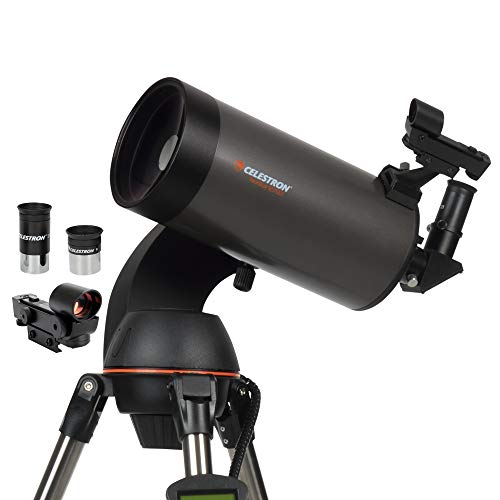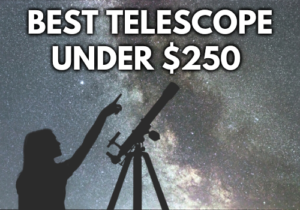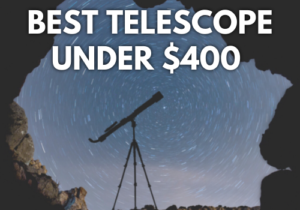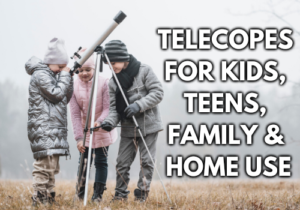7 Best Telescopes Under $1000 In 2025: Higher Magnification, Larger Apertures
Disclosure: This post contains affiliate links and I may earn a small commission (at no extra cost to you) if you click through and make a purchase. Thanks in advance – I really appreciate it!
Considering the number of options available in the marketplace today, choosing the best telescope under $1000 can be a challenging task.
When we decide to look for a telescope in a certain price range, each one of us might have different criteria to fulfill from our choice of scope.
Some of us might be looking for a Computerized GoTo model, some for a Dobsonian, APO model, or some of us might only be interested in astrophotography or just a good efficient telescope for our family at home.
With so many models and characteristics any modern telescope has, it becomes rather hard for both novices and pros to find the one.
We have painstakingly conducted countless hours of research, discussed specifications with fellow astronomers, and run detailed comparisons to find the best telescope below 1000 dollars for you.
Our Top Pick
Celestron – NexStar 127SLT
- Computerized star locating telescope: The Celestron NexStar 127SLT is a computerized telescope that offers a database of more than 40,000 stars, galaxies, nebulae, and more. The telescope locates your object with pinpoint accuracy and tracks it.
- Compact and portable: This telescope for adults and kids to be used together is ideal for weekend camping trips or excursions to dark sky sites.
Prices pulled from the Amazon Product Advertising API on:
Product prices and availability are accurate as of the date/time indicated and are subject to change. Any price and availability information displayed on [relevant Amazon Site(s), as applicable] at the time of purchase will apply to the purchase of this product.
Celestron’s NexStar 127SLT Telescope is perfect for anyone looking to take their astronomy hobby to the next level. With its Maksutov-Cassegrain design, this telescope can easily resolve detail on the Moon and planets, as well as reveal distant objects like galaxies and nebulae. Plus, its GoTo system makes it easy to locate and track celestial objects with just a few button presses. Whether you’re a beginner or experienced astronomer, the Celestron NexStar 127SLT Telescope is sure to impress.
Recommended Telescopes Under $1000
| Image | Title | Price | Buy |
|---|---|---|---|
 Top
Top | Celestron - NexStar 127SLT | See on Amazon | |
 Top
Top | Sky-Watcher Flextube 200 Dobsonian 8-inch | See on Amazon | |
 Top
Top | Celestron - NexStar 4SE Telescope | See on Amazon | |
 Top
Top | Sky-Watcher EvoStar 80 APO Doublet Refractor | See on Amazon | |
 Top
Top | Sky-Watcher 120mm Telescope | See on Amazon | |
 Top
Top | Celestron Astro Fi 102 Wi-Fi Maksutov | See on Amazon |
Product prices and availability are accurate as of the date/time indicated and are subject to change. Any price and availability information displayed on [relevant Amazon Site(s), as applicable] at the time of purchase will apply to the purchase of this product.
Prices pulled from the Amazon Product Advertising API on:Best Telescope Under $1000 - Reviews
1. Celestron - NexStar 127SLT (Best Computerized Pick)
- Type: Schmidt-Cassegrain
- Aperture: 127mm (5″)
- Focal length: 1500mm
- Focal Ratio: f/12
- Mount: Computerized Alt-az
- Eyepiece: 25mm, 9mm
- Magnification: 60x, 167x
- Weight: 18.0 lbs.(8.2 kg)
- Our Rating: 9.6/10
Prices pulled from the Amazon Product Advertising API on:
Product prices and availability are accurate as of the date/time indicated and are subject to change. Any price and availability information displayed on [relevant Amazon Site(s), as applicable] at the time of purchase will apply to the purchase of this product.
Our #1 pick for the best telescope under 1000 dollars is the Celestron NexStar 127SLT.
This is an entry-level GoTo telescope that is perfect for anybody wanting to enjoy the night sky with a dependable instrument.
This Celestron 127mm telescope has a 127mm aperture and SkyAlign technology, which gives users nice views. Furthermore, the single fork arm and basic design of the telescope make it simple to set up and use.
The focal length of the scope is 1500mm, and it features an f/12 focal ratio. Each Celestron NexStar 127 SLT telescope comes with a 25mm eyepiece and a 9mm eyepiece, both of which have a maximum magnification of 167x when used with the default 9 mm eyepiece.
The Celestron NexStar 127 SLT telescope stands on top of a motorized Altazimuth mount, which can be controlled via the provided digital hand controller.
The 127 SLT with its large aperture is great for viewing the surface of the moon, phases of Venus, rings of Saturn or Jupiter and its four largest moons, and other deep-space objects.
Why is NexStar 127SLT the best telescope under $1000?
We are delighted with the performance of the NexStar 127 SLT. If you’re an observer, who is mainly interested in planetary or lunar views with an occasional dabble in deep-sky observations, then this telescope is an affordable instrument with stunning optics — views get even better with additional eyepieces.
The telescope comes with a 2-year warranty. At 18 lbs, the telescope is very portable. The controls and SLT automation make it extremely easy to use (alignment can be easily done via GPS coordinates); and it provides great images at the price point with its 60x and 167x magnification, 127mm aperture, and 1500mm focal length.
Pros
- Super optical construction
- Very easy to operate with
- Compact and portable design
- Included needed additional accessories
- Suitable for lunar/planetary astrophotography
Cons
- Drains away batteries rather quickly
2. Sky-Watcher Flextube 200 (Best Dobsonian Under $1000)
- Type: Newtonian Reflector
- Aperture: 203mm (8”)
- Focal length: 1200mm
- Focal Ratio: f/6
- Mount: Dobsonian
- Eyepiece: 25mm, 10mm
- Weight: 50 lbs.(22.7 kg)
- Our Rating: 9.6/10
Prices pulled from the Amazon Product Advertising API on:
Product prices and availability are accurate as of the date/time indicated and are subject to change. Any price and availability information displayed on [relevant Amazon Site(s), as applicable] at the time of purchase will apply to the purchase of this product.
Sky-Watcher’s 8″ Collapsible Dobsonian Telescope has an elegant truss tube design that was meticulously developed to provide ease of use, extreme portability, and constant performance in a budget-friendly package.
The telescope comes with a great focal length of 1200mm and with a focal ratio of f/6.
The Sky-Watcher 8″ Collapsible Dobsonian features a 2″ single-speed Crayford style focuser and comes with a 1.25″ adaptor.
Unlike other truss tube designs, the Sky-Watcher Collapsible Dobsonian does not need to be disassembled between uses.
It transports as two compact pieces that can be assembled and ready to use in minutes. It is easy to collimate once set up, and it holds its collimation throughout the viewing sessions.
It is essentially a Dobsonian style Newtonian with a large 8″ aperture which is ideal for beginners who can invest a fair amount as well as professionals.
It comes with 25mm and 10mm 1.25” super Plossl eyepieces. Metal construction, captive recesses on the barrels, and rubber fold-down eye-cups make these good quality eyepieces that are certainly adequate to get you started.
Why We Recommend It
The Flextube 200 is undoubtedly the best telescope for DSOs under 1000 dollars as it has a low-hassle OTA design which is not only simple in construction and use but it also provides the viewer with maximum light for viewing deep-space objects without any aberrations or blurriness.
The mount construction is sturdy and rigid. Mount design, while simple, facilitates smooth motions about both axes.
The Sky-Watcher 8” comes with quality accessories that enhance the observer’s viewing experience.
Pros
- Easy to transport due to collapsible tube design
- An amazing light bucket for DSOs
- Easy to use
- Can be used by beginners & professionals
- Guaranteed to last long as its built with high-quality materials
Cons
- Some may find it heavy
- Doesn’t come with a Barlow lens
3. Celestron - NexStar 4SE Telescope (Best Mak-Cass)
- Type: Maksutov Cassegrain
- Aperture: 102 mm / 4.1″
- Focal length: 1325 mm
- Focal Ratio: f/13
- Mount: Motorized; Alt-Azimuth Single Fork
- Eyepiece: 25mm
- Weight: 21.0 lb (9.5 kg)
- Our Rating: 9.2/10
Prices pulled from the Amazon Product Advertising API on:
Product prices and availability are accurate as of the date/time indicated and are subject to change. Any price and availability information displayed on [relevant Amazon Site(s), as applicable] at the time of purchase will apply to the purchase of this product.
The NexStar 4SE is a little workhorse and definitely one of the best Maksutov Cassegrains for under 1000 dollars. It allows for a lot of possibilities between GoTo, astrophotography, and excellent visual use for both celestial and terrestrial viewing.
It’s a “slow” telescope, so high-power observation is its strong suit, so you will absolutely be disappointed if you’re after whopping fields of view.
The NexStar 4SE is equipped with a GoTo Mount and the SkyAlign software and a massive database, allowing you to easily find over 40,000 celestial objects, including planets, stars, clusters, galaxies, and nebulae.
The stability of the tripod and the strength of the motors are big concerns for GoTo users, but with a small and lightweight telescope like this, those concerns are not a problem.
With 4 inches / 102 millimeters of aperture, the NexStar 4SE is a fairly small telescope. This means that the images will be dimmer than with bigger telescopes in the series.
However, the lightweight design makes it easy to take this telescope into the mountains or another area without light pollution, meaning that you will be able to view all celestial objects in the sky.
Why We Recommend It
Celestron’s NexStar 4SE is a great choice telescope for the casual observer who simply wants to enjoy views of the moon, stars, and planets without the hassle and fuss of complicated setup, collimation, or locating and tracking objects manually.
The NexStar 4SE is a great starter telescope that offers a 2-year warranty. You can set the NexStar 4SE up quickly in the backyard, easily pack and port it around.
Coming in at 21 lbs, it’s lightweight enough for travel/camping.
It provides great images at the price point with its 53x magnification and 102mm aperture. The NexStar 4SE is even capable of astrophotography with the right accessories.
Pros
- Very sharp optics
- Good quality mount
- Decent aperture
- Very stable
- Good quality low-power eyepiece
Cons
- Small maximum field of view
- Somewhat heavy
4. Sky-Watcher EvoStar 80 (Best APO For Astrophotography)
- Type: Apochromatic Refractor
- Aperture: 80 mm(3.2″)
- Focal length: 600mm
- Focal Ratio: f/7.5
- Eyepiece: 20mm, 5mm
- Weight: 6.6 lbs.(3 kg)
- Our Rating: 9.2/10
Prices pulled from the Amazon Product Advertising API on:
Product prices and availability are accurate as of the date/time indicated and are subject to change. Any price and availability information displayed on [relevant Amazon Site(s), as applicable] at the time of purchase will apply to the purchase of this product.
The Sky-Watcher EvoStar ED80 is a modestly wide-field telescope offering bright, wide swaths of sky in a single view.
It is well suited for wide-field astronomical observation of prominent nebulae, star clusters, and galaxies from a dark-sky location, or can be used as an astrograph for sky photography.
The telescope can be used for terrestrial viewing, but it is not well suited for high-magnification observation.
The Sky-Watcher EvoStar 80 telescope weighs just under 7.3 lbs, making it highly transportable.
The Sky-Watcher ED-APO design guarantees that secondary, residual false-color is virtually eliminated in two-element achromatic lens systems as it uses Crown and Flint glass.
The telescope includes two long eye relief eyepieces that produce 30x and 120x magnification, a 90° star diagonal for more comfortable viewing, and a large 8×50 erect-image finderscope to make finding your celestial objects faster and easier.
Finally, to keep the OTA safe and secure during storage and transportation, Sky-Watcher includes a foam-lined aluminum carrying case.
Why We Recommend It
This moderately wide-field telescope covers large swaths of the sky in a single view for optimal wide-field astronomical observation of eye-catching nebulae, star clusters, and galaxies from any location with dark skies.
If you’re looking for a telescope for professional astrophotography under $1000, then the Sky-Watcher Evostar 80ED is the scope for you. When used as a spotting scope or telephoto lens for terrestrial viewing, the Sky-Watcher Evostar 80ED provides absolutely superb performance with ultra-high contrast to highlight even the minutest of details when examined under good seeing conditions.
The small size of the Sky-Watcher Pro ED80 makes for an excellent compact, portable telescope that travels light and fits a small space.
At about 50-power structural detail becomes apparent in our solar system’s gas giants like Saturn and Jupiter. The Moon also exhibits striking crater detail along the lunar terminator. The
Sky-Watcher Pro ED80 is a great telescope for the intermediate visual observer.
The telescope has an Advanced Coma-Free (ACF) optical system which produces flatter images that are free of coma and other aberrations.
The Pro ED80 Telescope is one of the best telescopes under $1000 for planetary observation and advanced deep sky astrophotography with its Advanced Coma-Free (ACF) optics.
Pros
- Simply stunning optical image quality
- Perfect for anyone who does professional astrophotography
- Great for imaging DSOs
Cons
- Not great for casual viewing
- Does not come with a mount or base
5. Orion 9005 AstroView 120ST (Best Refractor Pick)
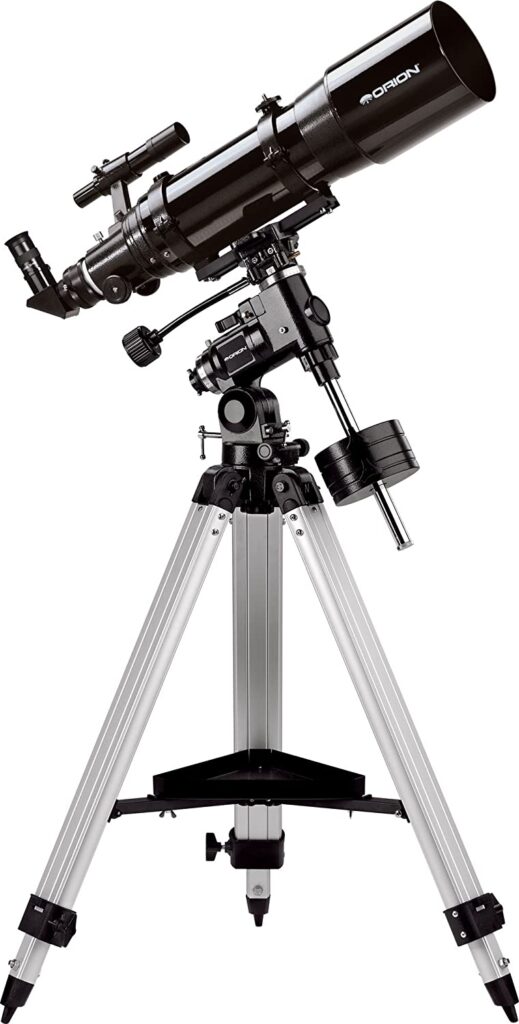
The Orion AstroView 120ST EQ Refractor is a compact, rich-field refractor designed for observation of nebular clouds, star clusters, and even galaxies.
It has a 120mm (4.7″) clear aperture and a focal length of just 600mm (f/5). This
This means that it can provide sharp, high-resolution images of objects up to magnitude +14.
Due to its short focal length and fast optics, the Orion 90051AstroView 120ST is also a good choice for lunar and planetary observation. It can easily resolve details down to about 0.75″ on planets like Jupiter and Saturn, making it a great choice for intermediate and experienced observers alike.
The AstroView 120ST also comes with a number of features that make it an excellent value for the price.
These include a dovetail finder scope base, two-speed Crayford focuser, and multicoated optics. It also has a very sturdy mount that can easily support a DSLR camera and ball head for astrophotography.
The AstroView 120ST is an excellent choice for intermediate and beginner observers alike looking to get into a high-quality refracting telescope for under 1000 dollars.
Why We Recommend It
For families, casual observers, and new astronomy enthusiasts, the Astroview 120ST from Orion is an ideal telescope to begin exploring the night sky.
This amazing telescope is excellent for deep-space viewing, and it represents a relatively affordable grab-and-go option that anyone will be able to enjoy right out of the box.
At almost five inches, this is a large refractor, which is why it commands a relatively large price tag too.
But that huge objective lens brings a level of clarity and detail that is hard to come by in cheaper refractor telescopes.
Pros
- Very portable for the size of the optics
- Good optical specs
- Decent included accessories
- Lower maintenance
- Easy to set up
Cons
- May suffer from chromatic aberration
- Subpar finderscope
6. Sky-Watcher Startravel 120 (Most Versatile)
- Optical Design: Achromatic Refractor
- Aperture: 120 mm / 4.7
- Focal Length: 600 mm
- Focal Ratio: f/5
- Type: Manual; Alt-Azimuth
- Weight: 8.6 lb / 3.9 kg
Prices pulled from the Amazon Product Advertising API on:
Product prices and availability are accurate as of the date/time indicated and are subject to change. Any price and availability information displayed on [relevant Amazon Site(s), as applicable] at the time of purchase will apply to the purchase of this product.
The Sky-Watcher StarTravel 120mm f/5 AZ Refractor Telescope is a compact yet powerful optical tube assembly (OTA) that can be used to see detailed views of celestial objects from the moon to bright deep-sky objects, or as a conventional spotting scope to enjoy high-resolution and close-up observations of wildlife, birds, or boats.
It is also portable enough to be used as a grab-and-go option over larger and heavier scopes, or it can be easily removed from the included mount and set up on a dual-mount rig for astrophotography.
The Sky-Watcher Startravel 120 is a very good option for those on a limited budget – especially those searching for an all-inclusive package that’s both easy to set up and use.
Stargazers are treated to excellent quality eyepieces, Barlow lens, a decent-quality tripod, accessory tray, and DSLR camera adapter for those who want to attach a DSLR camera with this mount. There’s also a handy shutter-release port on the mount for easy imager management.
It has a fully multi-coated achromatic doublet lens design that corrects for spherical and chromatic aberrations, resulting in clear, bright photos that aren’t distorted across the whole field of view. With true color accuracy,
The large 120mm aperture makes it perfect for the detailed moon and planet viewing as well as deep-sky observations, such as binary stars, clusters, and galaxies.
Why We Recommend It
The StarTravel-120 is a beautiful astronomical telescope, with its black tube, white tube rings, and dew shield, as well as white SkyWatcher branding.
The supplied 10mm and 25mm eyepieces are superior to those included in Telescope Package Deals such as freebies, whilst the 2x Barlow, which doubles the magnification of whatever eyepiece you’re using, is excellent.
The eyepieces, which come with a 24x and 60x objective power, have their own magnification of 24x and 60x without the Barlow lens, but they increase to 48x and 120x when used with the Barlow lens.
The Startravel 120 is a fast telescope with a focal ratio of f/5, making it ideal for deep-sky observing and astrophotography.
The images are reasonably sharp, with single and double stars looking crisp and contrasty, craters on the Moon looking bright and clear, and star fields being distinct to about three-quarters of the way across their field of view.
Pros
- Good value for money
- Versatile – can be used for visual observing or imaging
- Great optics
- Nice included accessories
Cons
- Extra accessories are needed to make it astrophotography-ready
- Some chromatic aberration
7. Celestron Astro Fi 102 (Best with Wi-Fi)
- Optical Design: Maksutov Cassegrain
- Aperture: 102 mm / 4
- Focal Length: 1325 mm
- Focal Ratio: f/13
- Mount: Motorized; Alt-Azimuth Single Fork
- Weight: 13.6 lb / 6.2 kg
Prices pulled from the Amazon Product Advertising API on:
Product prices and availability are accurate as of the date/time indicated and are subject to change. Any price and availability information displayed on [relevant Amazon Site(s), as applicable] at the time of purchase will apply to the purchase of this product.
The Celestron’s Astro Fi 102mm f/13 Maksutov-Cassegrain Telescope utilizes an integrated antenna to emit a local Wi-Fi signal so you can control the mount via direct wireless connection with Android and iOS smartphones and tablets running the free SkyPortal app.
The telescope’s Maksutov optics make it best for high magnification rather than wide-angle viewing. It’s good at cutting through the light pollution of urban areas to make deep-space viewing possible no matter where you are.
The telescope is not hugely bulky or particularly heavy, and it offers a variety of automated realignment procedures that make it easy to set up in a new location and start tracking stars quickly.
The Astro Fi 102 is definitely one of the best telescopes under $1000 which is also wi-fi enabled as it produces its own wireless signal for interaction with smart devices even in isolated places.
Celestron’s award-winning SkyAlign technology makes for quick, effortless observing preparation. Your telescope will automatically determine its position when you center any three bright objects in the eyepiece.
There is even a Sky Tour option that will show you all the best celestial highlights based on the current time and your precise location
Why We Recommend It
The Astro Fi 102 is very different from other GoTo telescopes.
Like other computerized telescopes, the Astro Fi has no hand controller, no set of manual pointing knobs, and no need for a laptop cabled to the mount.
You just hold your phone or tab up to the night sky, and the scope will accurately track what’s up tonight. Just touch an on-screen target, and your Astro Fi scope will slew to and center that sight, while your smart device displays information about the object.
Optically, the 3.5-inch (90mm) aperture is quite decent and serves its purpose.
The lens coatings do a fair job of contrast improvement. With a focal ratio of 10.1, it is not especially “fast.” But if you have clear, dark skies, you won’t need more speed.
The Astro Fi 102 Mak-Cas is compact and produces clean and bright images of stars, planets, and nebulae.
Pros
- Easy to use
- Suitable for astrophotography
- High-quality optics in addition to computerized mount
- Relatively portable
- Good for high-magnification and deep space viewing
- Great companion app
Cons
- The eyepieces are mediocre
- Some users report connectivity issues
How To Choose A Telescope Under $1000
If you are looking for the best telescope under $1000 then you are bound to encounter a wide variety of choices. The telescopes for under $1000 are ideal for amateurs to intermediates to advanced as well.
A telescope in this price range will enable you to view planetary details like shadows and texture of the moon, nebulae and galaxies, among other objects.
Features To Look For In A Telescope Under $1000
These are the main features we assessed when comparing different models to come up with our best telescope under $1000 list. Taking them into consideration will ease the burden of choice.
Type Of Telescope
The telescopes, for all their varied shapes and sizes, types of telescopes can be divided into three classes: refractors, reflectors, and catadioptrics.
1. Refractor Telescope
The refractor telescope uses a lens to gather and focus light. The first telescopes built were refractors. The glass lens is at the front of the telescope and light is bent (refracted) as it passes through the lens.
Refractor telescopes are rugged. After the initial alignment, their optical system is more resistant to misalignment than the reflector telescopes.
The glass surface inside the tube is sealed from the atmosphere so it rarely needs cleaning.
2. Reflector Telescope
The second type of telescope, the reflector telescope, uses a mirror to gather and focus light. Its most common form is the Newtonian reflector, with a specially curved concave primary mirror in the bottom end of the telescope.
Near the top a small, diagonal secondary mirror directs the light from the primary to the side of the tube, where it’s met by a conveniently placed eyepiece.
If you want the most aperture for your money, the reflector is the scope for you.
3. Catadioptric Telescope
The third type of telescopes are the catadioptric or compound telescope. These were invented with the desire to combine the best characteristics of refractors and reflectors: they employ both lenses and mirrors to form an image.
The greatest appeal of these instruments is that, in their commonly encountered forms (the Schmidt-Cassegrain and Maksutov-Cassegrain), they are very compact.
Their tubes are just two to three times as long as wide, an arrangement allowed by “optical folding” of the light. The smaller tube can use a lighter and thus more manageable mounting. The upshot is that you can obtain a large-aperture, long-focus telescope that’s very transportable.
Aperture
The most important aspect of any telescope is its aperture, the diameter of its main optical component, which can be either a lens or a mirror.
A scope’s aperture determines both its light-gathering ability (how bright the image appears) and its resolving power (how sharp the image appears). When learning how to choose a telescope, knowing all you can about the aperture is crucial to your ability to see the night sky.
This simply means – the bigger the aperture the better. With a 6-inch telescope you can discern craters on the Moon as small as about a mile across — half the size of those visible in a 3-inch scope (under the same conditions using the same magnification).
Focal length
Focal length is the distance from the main optical component where light is gathered to the point where it is brought to a focus for the eyepiece to form an image. This obviously influences the level of magnification. A long focal length has higher magnification but offers narrower fields of view than a short one. It is suitable for objects that are closer like the moon, stars and planets.
To observe distant galaxies, choose a telescope with a short focal length and large diameter that provide wider and brighter views.
Mounts
The best telescope in the world is useless unless it’s on a solid, stable, smoothly-working mount, one that permits it to be directed to the desired part of the sky and to follow a celestial object smoothly and precisely as the Earth turns beneath it.
Investing in a good mount will give you years of use even after you have upgraded your telescope.
Eyepieces
Eyepieces determine the magnification and field of view of a telescope. Different eyepieces are used to view different objects.
Some objects, such as nebulae and star clusters, appear quite large and are best viewed at low magnifications (which give a wider field of view), whereas planets appear very small and are normally viewed with high-magnification eyepieces.
There are two standard sizes of telescope eyepieces. The sizes are determined by the diameter of the eyepiece barrel that fits into the telescope. The two standard sizes are 1.25″ and 2″.
Weight
The size and weight of the telescope you are willing to carry is probably the biggest problem one must ponder.
Telescopes can range from around 15 lbs. to well over 300 lbs. Most can be broken down into 3 subsections for transportation: the optical tube assembly, the telescope mount, and the tripod or base. Remember, if the scope is too heavy, you may not use it at all.
Magnification
The magnification (power) of a telescope is variable and depends upon the eyepieces one uses. The power is computed by dividing the focal length of the primary objective (aperture) of the telescope by the focal length of the eyepiece being used.
Frequently Asked Questions (FAQs)
What is the best telescope to see planets with?
There are a few things you need to take into account when choosing the best telescope for viewing planets. The first is aperture size – the larger the aperture, the more light the telescope can collect, and therefore the better it will be at picking out finer details on planets.
Secondly, you need to consider magnification – telescopes with a higher magnification will be able to show you more detail on planets, but they will also be harder to keep stable. Finally, it’s important to think about the type of telescope – reflectors tend to have larger apertures than refractors, making them better for viewing planets.
What kind of telescope can I get for $1000?
You can get very powerful telescopes for under 1000 dollars! This article itself has 7 such amazing telescopes that cost under $1000. As telescopes have advanced over the years to include computerized models that can automatically move and find objects in the sky for you.
The best telescope under $1000 will provide excellent views of stars, planets, nebulae galaxies, even comets.
What brands make the best telescopes under $1000?
One of the best brands is Orion Telescopes & Binoculars. They offer telescopes with powerful magnification, large apertures and superior optical quality at very affordable prices.
Other good brands are Celestron and Meade Instruments which provide high-quality premium products without compromising too much on price. Telescope accessories like tripods, eyepieces, and filters add to the overall price of a telescope.
The best brands offer telescopes under 1000 dollars with large enough apertures and magnification so that you can view planets in spectacular detail or even see distant galaxies, star clusters, and nebulae.
How powerful does my telescope need to be to see planets like Jupiter?
This really depends on the size of the telescope’s aperture. Larger telescopes will be able to view planets in more detail than smaller ones. However, even a small telescope can give you impressive views of Jupiter and other planets if it has a high magnification. So, don’t let the size of your telescope deter you from viewing some of the most impressive objects in our Solar System, such as Jupiter.
Can you see deep sky objects with a telescope under $1000?
You bet you can! Any telescope in this list of the 7 best telescopes under $1000 will give you stunning views of the moon, planets, and deep-sky objects such as nebulae, star clusters, and galaxies.
In this list, we’ve included telescopes with large apertures and high magnifications so that you can view even the most distant objects in stunning detail.
Conclusion
When you are looking for a telescope, it is important to know what your needs will be. This list of the 7 best telescopes under $1000 should help you find one perfect for your situation. What type of astronomer do you want to be? Are you interested in exploring space or just viewing things on Earth? Let this list guide you towards finding the telescope that suits you the best!
Written by:

Chandrashekhara Rao
I grew up in a rural community with a dark sky, and that is where I learned to appreciate planets and stars at an early age. I have been fascinated with all things astronomical since I was a kid and started with a cheap-and-cheerful 60mm refractor on a wobbly tripod.
ABOUT US
We are a team of active amateur astronomers, here to help you with all your astronomy and science related needs – this is anything, from reviewing the latest telescopes to be released to talking about gravity and neurons. The Big Bang Optics was started because of our love for astronomy and to help others like us find the best telescope and accessories.
LEGAL DISCLAIMER
The Big Bang Optics is a participant in the Amazon Services LLC Associates Program, an affiliate advertising program designed to provide a means for sites to earn advertising fees by advertising and linking to Amazon.com. The Big Bang Optics also participates in affiliate programs with Clickbank and other sites. The Big Bang Optics is compensated for referring traffic and business to these companies.

